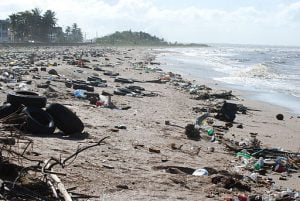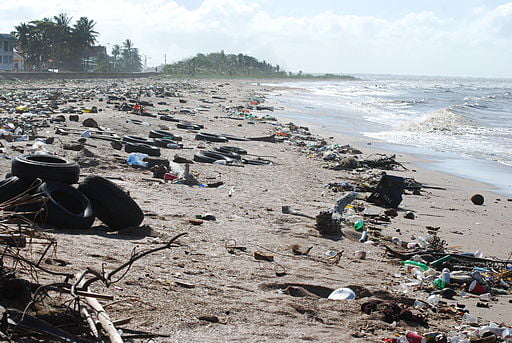
Read all about the problems with plastic waste, in the article excerpts which follow, and also go and read the full articles at the linked websites:
Brits dumped more than a million tonnes of plastic waste in 2016 amid recycling concerns
THE scale of Britain’s plastic packaging nightmare was laid bare yesterday as figures revealed more than a million tonnes was dumped in 2016.
One of the biggest problems with plastic waste is that the recycling rate being achieved is low. Just 44.9 per cent of 2.26 million tonnes of plastic waste was recycled – almost half the rate for paper and cardboard, the Department for Environment admitted.
It came as green campaigners united to demand the Government set new “ambitious and legally binding” targets to deal with Britain’s ever growing “packaging waste mountain”.
Britain’s overall packaging waste recycling rate in 2016 edged up to 71.4 per cent in 2016 – the most recent year on record – below the 72.2 per cent achieved in 2013.
Campaigners admitted the amount of plastic packaging waste going to landfill or being destroyed has gone down from 1.5million tonnes to 1.2million since 2013 – a 20 per cent drop.
But Sarah Baulch, senior oceans campaigner at the Environmental Investigation Agency, said: “If we want to avoid seeing turtles trapped in bags and six-pack wrappers and whales washed up on shores dead from ingesting plastic, we need to get drastic on plastic. via Brits dumped plastic
There's so much plastic in the ocean, you're probably eating it in seafood
In 2015, volunteers of the Ocean Conservancy's International Coastal Cleanup event collected almost 1 million plastic beverage bottles, 800,000 plastic bottle caps, and about half a million each of plastic bags and drinking straws — all in just a single day.
The conservancy estimates 90 percent of seabirds are now eating plastics regularly. This is possibly the biggest of the many problems with plastic waste. A third of all leatherback turtles have plastic in their stomachs — they often mistake plastic bags for the jellyfish they feed on.
Eventually some of the plastic that humans have released into the oceans comes full circle. Micro-plastics make their way into the guts of harvested fish and shellfish, which are then consumed by humans. You could very well be swallowing microscopic plastic particulate with every bite of your tilapia filet. via plastic in seafood
Dumping of billions of tonnes of plastic waste is ‘uncontrolled experiment' on planet Earth, scientists warn
Of the many problems with plastic waste is that of “unforeseen circumstances”. Humans are carrying out an “uncontrolled experiment on a global scale” by dumping vast amounts of plastic into the natural world, according to researchers who estimated the total amount produced since the artificial material became widely used in the 1950s.
They found 8.3 billion metric tonnes of plastic had been produced over the period, creating 6.3 billion tonnes of waste.
And 79 per cent of that was thrown away, either into a landfill site or the environment with just 9 per cent recycled and the rest incinerated.
The figures came as Surfers Against Sewage launched a campaign to persuade people to resist single-use plastics, saying the average person threw away the equivalent of 1,212 Coca Cola bottles or 4,600 plastic forks every year. via Dumping plastic waste
Horrified British diver reveals ocean off picturesque holiday hotspot Bali is completely clogged with plastic that’s killing wildlife
ALARMING footage of a British diver swimming through swathes of plastic rubbish reveals the harrowing extent of global ocean pollution. here is another of the many, and growing, problems with plastic waste.
Richard Horner, 45, who has been living and diving in Bali for more than five years, can be seen twisting and turning through the water, in a bid to avoid a deluge of wrappers and bags floating into him. via Horrified British diver
But, is this situation impossible? No it is not. International co-operation will be essential, and there will be costs, but the World Economic Forum has an answer which is described in the section below:
8 Steps to Solve the Ocean’s Problems with Plastic Waste – World Economic Forum
The ocean provides us with everything we need: food, oxygen, inspiration and jobs. It also regulates the climate. Despite its vital importance, we are currently treating our ocean like an enormous dump. A whole garbage truck’s worth of plastic ends up in the ocean every minute, and we are way overdue in doing something about the problem. The good news is that this is a problem that can be solved.
This is probably just the beginning. The plastic problem is enormous, but it can be solved, and it is urgent that we take steps now to do so.
Eight essential steps we can take to alleviate the problems of plastic waste:
- We must reduce our plastic dependency
We use an incredible quantity of single-use plastic items, such as straws, plastic bags, packaging, plastic cups, plates and cutlery. We must put an end to it.
2. Increased producer responsibility
Alternatives to non-degradable plastics must be developed, and the industries responsible for the major plastic wastes must be targeted with specific industry agreements and producer liability arrangements, with requirements for handling, collection and reuse of waste and broken plastic equipment.
3. Increase fees and taxes on polluting plastics
Fossil plastic is still cheaper to make and buy than the renewable versions. Governments need to investigate implementing a tax or fee on polluting plastics. The fees must be changed so that recycled plastic becomes cheaper than fossil.
4. Increased waste management where the problem is greatest
The bulk of plastic waste comes from developing countries. As part of the solution, an international aid programme should be established to develop waste management and recycling infrastructure in the developing nations.
5. Implementation of the zero vision for ocean plastic
In December 2017, the UN Environment Assembly adopted a global goal to stop the discharge of plastic to the sea. As a follow-up, an international agreement with firm targets and time frames for implementation should be established, ensuring the mapping of sources of marine waste, increased market responsibility to prevent new propagation and strengthening of waste management globally.
6. Increased mapping, surveillance and research
There is still much we do not know about the plastic problem. Researchers estimate that more than 70 percent of the plastic ends up on the sea floor. Over time, it breaks down into tiny particles, but we do not know what happens to this material or how to get rid of it. The efforts to map and monitor, as well as conduct research on the negative effects, must be strengthened. An important initiative in this direction is REV, the world’s largest research and expedition vessel, which aims to solve the biggest challenges around the ocean, including a dedicated effort on plastic.
Have you read?
7. Stop the flow of plastic waste into the sea
Around 80 percent of the plastic in the ocean is suspected to come from activities and industry on land. This can include everything from car tyres, technical sports equipment and fleece clothing, to cigarette butts and cotton buds. Everyone can and should contribute to the solution. For example, you can participate in clean-up operations, cut your own plastic consumption and of course always pick up any garbage you find along your way.
8. Increased funds for clean-up
To solve the problems with plastic waste, we must ensure that action and clean-up operations are undertaken in areas where the problem is the greatest. Much of the work, however, is hampered due to the lack of financial resources. By establishing a global ocean fund, with waste management and clean-up of marine areas high on the agenda, we will be one step closer towards the goal: a future without plastic and marine pollution in our ocean. via steps solveocean’s plastic
Conclusion: Problems with Plastic Waste Mount Up
There is no need to despair about the state of the oceans of the globe. It is all curable!
We have provided information on the plastic problems in the world, by providing plastic pollution facts.
There are problems with recycling plastic, and an urgent set of actions will be essential to curb the tide of plastic pollution in the ocean. But, problems with plastic in the ocean are just one part of society's more general need for plastic problems solutions. Now that the attention of the scientific and engineering communities has been raised on this we can now look for plastic pollution solutions to be found and delivered over the next 20 or so years.
We have been hard on the UK in this article, but in reality the nation has not done too badly on recycling. It's in the Top 10 world recycling nations. Find out more about the top recycling nations here.






It’s not only batteries. battery waste is toxic and really bad. Use rechargeable batteries instead of regular ones. Batteries are harmful for the environment if not recycled properly: you can reduce the amount of batteries that need recycling by using the same ones for a long time. Invest in a good brand and get a battery charging device to power your children’s toys and other appliances.
Its just ticking bomb of toxin.
Its awful. An enormous pile of plastic waste floating in the Pacific Ocean covers an area more than twice the size of France after scientists found it was at least four times bigger than previously estimated. Shocking.
It feels more like sweeping the dust under the carpet.?
I LIKE THAT YOU TACKLED THIS TOPIC!!! QUIT PLASTIC! NEW CONCEPTS FOR BIODEGRADABLE PLASTIC ARE THE ANSWER. INNOVATORS MUST BE EXTREMELY CREATIVE TO HALT THIS DISASTER FOR ANIMALS IN THE SEA. THANKS.
Hi.. it’s excellent.. especially the last one is so unique..?
it is good idea? Add plastic to food and we won’t put weight-on. Overweight is a crisis. So what’s bad about plastic.